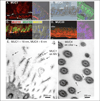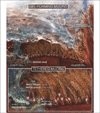Molecular organization of the mucins and glycocalyx underlying mucus transport over mucosal surfaces of the airways
- PMID: 22929560
- PMCID: PMC3637662
- DOI: 10.1038/mi.2012.81
Molecular organization of the mucins and glycocalyx underlying mucus transport over mucosal surfaces of the airways
Abstract
Mucus, with its burden of inspired particulates and pathogens, is cleared from mucosal surfaces of the airways by cilia beating within the periciliary layer (PCL). The PCL is held to be "watery" and free of mucus by thixotropic-like forces arising from beating cilia. With radii of gyration ~250 nm, however, polymeric mucins should reptate readily into the PCL, so we assessed the glycocalyx for barrier functions. The PCL stained negative for MUC5AC and MUC5B, but it was positive for keratan sulfate (KS), a glycosaminoglycan commonly associated with glycoconjugates. Shotgun proteomics showed KS-rich fractions from mucus containing abundant tethered mucins, MUC1, MUC4, and MUC16, but no proteoglycans. Immuno-histology by light and electron microscopy localized MUC1 to microvilli, MUC4 and MUC20 to cilia, and MUC16 to goblet cells. Electron and atomic force microscopy revealed molecular lengths of 190-1,500 nm for tethered mucins, and a finely textured glycocalyx matrix filling interciliary spaces. Adenoviral particles were excluded from glycocalyx of the microvilli, whereas the smaller adenoassociated virus penetrated, but were trapped within. Hence, tethered mucins organized as a space-filling glycocalyx function as a selective barrier for the PCL, broadening their role in innate lung defense and offering new molecular targets for conventional and gene therapies.
Figures








References
-
- Florey H, Carleton HM, Wells AQ. Mucus Secretion in the Trachea. Br J Exp Pathol. 1932;13(3):269–284.
-
- Lucas AM, Douglas LC. Principles underlying ciliary activity in the respiratory tract. Arch Otolaryngol. 1934;20:518–541.
-
- Yoneda K. Mucous blanket of rat bronchus: an ultrastructural study. Am Rev Respir Dis. 1976;114(5):837–842. - PubMed
Publication types
MeSH terms
Substances
Grants and funding
LinkOut - more resources
Full Text Sources
Other Literature Sources
Research Materials
Miscellaneous

